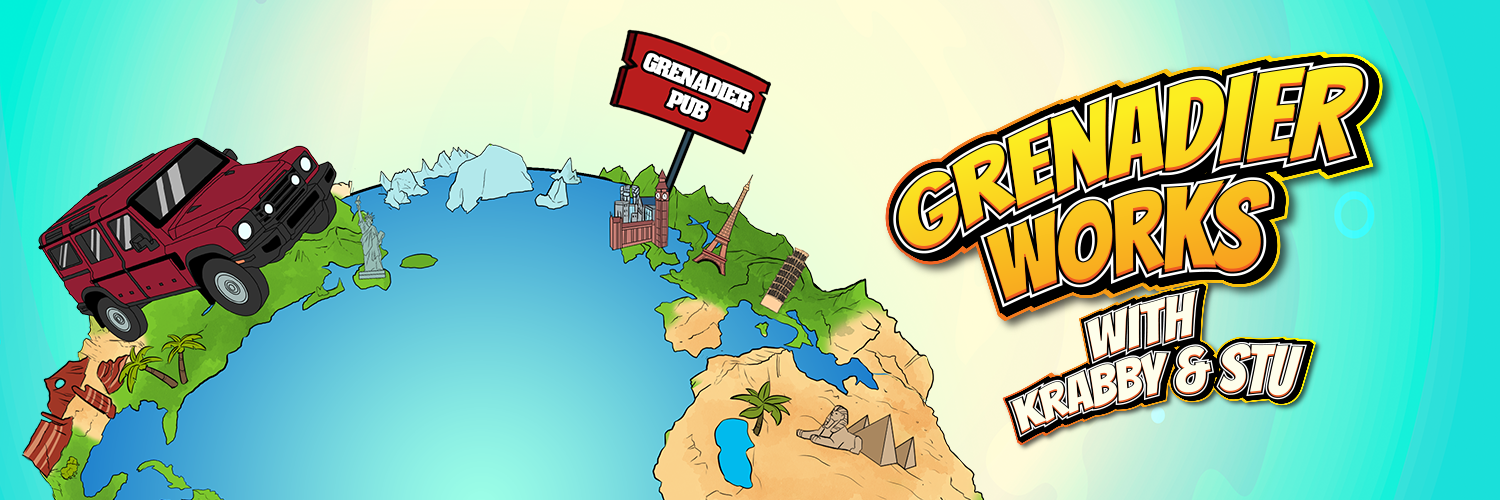The Grenadier Forum
Register a free account today to become a member! Once signed in, you'll be able to contribute to the community by adding your own topics, posts, and connect with other members through your own private inbox! INEOS Agents, Dealers or Commercial vendors please use the contact us link at the bottom of the page.
You are using an out of date browser. It may not display this or other websites correctly.
You should upgrade or use an alternative browser.
You should upgrade or use an alternative browser.
Tks Rab. The c clip being located where?Looks like a c clip failure @ECrider, everything else looks intact.
Is there thinking the c clip fails because of the angle of dangle between tc and diff?
I'm still trying to read through all the various threads.
Apparently mine was caused by a C clip failure so maybe a theme ?. I don’t know actually where the C clip is located.Tks Rab. The c clip being located where?
Is there thinking the c clip fails because of the angle of dangle between tc and diff?
I'm still trying to read through all the various threads.
C clip should be in the groove at the end of the splined shaft to retain the shaft in the cv joint. Hard to tell without a clean shaft picture (easy matron) but the circlip groove looks worn. With some previous comments about heated joints I had some concerns about dry bearings but there seems to have been adequate lubricant in there.
Another one bites the dust.....Tks Rab. The c clip being located where?
Is there thinking the c clip fails because of the angle of dangle between tc and diff?
I'm still trying to read through all the various threads.
These images are from the Teraflex instructions. It's the same setup. The spline on the shaft slides through the CV and is retained by the c-clip (labelled here as a snap ring).
For reasons not yet known, there has been several instances where the c-clip has dislodged and the shaft has separated from the CV.
@ECrider if you still have the driveshaft on your bench would you please see if the slip joint is free to expand and contract like an accordion. It might be a bit stiff but it should move, maybe 40 to 50mm or so. This lets the driveshaft length change as the front suspension travels up and down through an arc. I'm trying to understand what is putting pressure on the c-clip to cause it to come out of the groove.
Slip joint
I’m wondering if some number of shafts were built where the splines for the center slip joint were not machined long enough to allow for full suspension travel? It would require pulling some shafts apart but a comparison between two shafts with approximately the same mileage but one had a c-clip failure might be interesting.
I don’t think you’ll get any traction with a lifted vehicle. IA can’t back the independent dealership’s work, and they shouldn’t be expected to. The dealer perhaps should, being as they sold the car after increasing the shaft angle. I understand this doesn’t account for the stock failures, but I can’t imagine they’d accept the warranty work.I also planning to start the NTSB complaint. What happened recently is my friend have a lift installed by the dealer and they warrenty the first drive shaft failure, the second one failed after another 10k miles and they refused to warrenty this one now. I feel Ineos is really not taking their responsibility on this issue now.
Good thing there aren’t 12 year old boys on this thread.
Last edited:
Not by birth year...Good think there aren’t 12 year old boys on this thread.
The t/case circlip always seems to be the one that fails. If some failures are attributed to excessive force the circlip from the drive shaft slip joint I would expect a number of circlip failures at the differential end of the shaft. Ruling out defective components there are a couple questions; Is the sequence of events causing the clip to fail, the boot fails, the grease is ejected, the CV becomes excessively hot transfering heat into the circlip and the circlip loses tension allowing it to be dislodged? Would there be any benefit end for ending the drive shaft installation and moving the heaviest part and slip joint away from the t/case and at the axle?
- Local time
- 3:42 AM
- Joined
- Sep 25, 2021
- Messages
- 497
And I can’t see a company risking the liability from not fixing repeat failures that can hurt people…I can’t see a company that is loosing millions and laying of staff fixing a major issue like this until a new model is released and it’s a totally redesigned front diff
Hard to know what's going on here. Some heat decals or paint might catch it cooking off.The t/case circlip always seems to be the one that fails. If some failures are attributed to excessive force the circlip from the drive shaft slip joint I would expect a number of circlip failures at the differential end of the shaft. Ruling out defective components there are a couple questions; Is the sequence of events causing the clip to fail, the boot fails, the grease is ejected, the CV becomes excessively hot transfering heat into the circlip and the circlip loses tension allowing it to be dislodged? Would there be any benefit end for ending the drive shaft installation and moving the heaviest part and slip joint away from the t/case and at the axle?
Presumably IA oriented the shaft to move the slip joint up higher for a bit of environmental protection. Other than that it's shouldn't matter, I think..
That bruise on the end of the spline could be partial tear out caused by the clip as it departed the groove, or secondary damage while flailing about. I'm leaning towards B.
If there is any positive about this issue, so far I haven't seen any reports of CV failure with separation at the diff end. That's a potential spear and flip if the driveshaft can drop down enough to hit the ground. That would get the attention of the regulators.
I'm almost ready to pop my front shaft out, remove the cap and inspect the clip to see what condition it's in. I tried to buy a set of mounting bolts on Thursday but my agent is offline while the new business owners set up a dealer contract with IA. The driveshaft bolts are single use.
I'd really like someone to knock out a safety loop while this issue is in play. It's reactive but it might minimise the damage.
Last edited:
Tks Clark Kent for posting your usual quality. Appreciate the pics. That c clip/design to me looks so under engineered for retaining such a heavy part. Perhaps other bits are taking the load but a c clip????Another one bites the dust.....
These images are from the Teraflex instructions. It's the same setup. The spline on the shaft slides through the CV and is retained by the c-clip (labelled here as a snap ring).
For reasons not yet known, there has been several instances where the c-clip has dislodged and the shaft has separated from the CV.
@ECrider if you still have the driveshaft on your bench would you please see if the slip joint is free to expand and contract like an accordion. It might be a bit stiff but it should move, maybe 40 to 50mm or so. This lets the driveshaft length change as the front suspension travels up and down through an arc. I'm trying to understand what is putting pressure on the c-clip to cause it to come out of the groove.
View attachment 7913653
View attachment 7913649
Slip joint
View attachment 7913650
Yes the slip joint is noticeably free to move. Some resistance but takes little effort to compress. I was surprised when I first took it of.
Hi Rab. Yes as above, appears to slip as intended. There is some resistance but joint appears unbroken.Angle of shaft shouldn’t affect the circlip. Does the the driveshaft extend and retract easily, an interference or tight movement would be detrimental to the clip.
I'm thinking my gearbox bash plate I installed lessened potential damage a little bit. It prevented the prop from dropping right down when it parted and thus I'm thinking the arc it was flailing around was much reduced. Some retaining loop would be good.Hard to know what's going on here. Some heat decals or paint might catch it cooking off.
Presumably IA oriented the shaft to move the slip joint up higher for a bit of environmental protection. Other than that it's shouldn't matter, I think..
That bruise on the end of the spline could be partial tear out caused by the clip as it departed the groove, or secondary damage while flailing about. I'm leaning towards B.
If there is any positive about this issue, so far I haven't seen any reports of CV failure with separation at the diff end. That's a potential spear and flip if the driveshaft can drop down enough to hit the ground. That would get the attention of the regulators.
I'm almost ready to pop my front shaft out, remove the cap and inspect the clip to see what condition it's in. I tried to buy a set of mounting bolts on Thursday but my agent is offline while the new business owners set up a dealer contract with IA. The driveshaft bolts are single use.
I'd really like someone to knock out a safety loop while this issue is in play. It's reactive but it might minimise the damage.
@ECrider if you still have the driveshaft on your bench would you please see if the slip joint is free to expand and contract like an accordion. It might be a bit stiff but it should move, maybe 40 to 50mm or so. This lets the driveshaft length change as the front suspension travels up and down through an arc. I'm trying to understand what is putting pressure on the c-clip to cause it to come out of the groove.
That was my thought as well. If the clip had popped off, the shaft should at least be able to move slightly lengthwise. Therefore, I tried to move the shaft under the car with a pry bar. That didn't quite work, but I could hear a distinct click, the kind that sometimes occurs when these clips snap into place. Unfortunately, because of the crimped-on cover, you can't check whether the clip is seated correctly or not. I know from Renault that they once had problems with driveshafts where the slip joint wasn't sufficiently greased as standard. Since I've installed several driveshafts on old tractors and Land Rovers myself and fitted quite a few of these clips, I know how this kind of thing works and sometimes sounds.
That was my thought as well. If the clip had popped off, the shaft should at least be able to move slightly lengthwise. Therefore, I tried to move the shaft under the car with a pry bar. That didn't quite work, but I could hear a distinct click, the kind that sometimes occurs when these clips snap into place. Unfortunately, because of the crimped-on cover, you can't check whether the clip is seated correctly or not. I know from Renault that they once had problems with driveshafts where the slip joint wasn't sufficiently greased as standard. Since I've installed several driveshafts on old tractors and Land Rovers myself and fitted quite a few of these clips, I know how this kind of thing works and sometimes sounds.
Thanks for the feedback @ECrider.Tks Clark Kent for posting your usual quality. Appreciate the pics. That c clip/design to me looks so under engineered for retaining such a heavy part. Perhaps other bits are taking the load but a c clip????
Yes the slip joint is noticeably free to move. Some resistance but takes little effort to compress. I was surprised when I first took it of.
We don't know what is causing the clip to come out of the groove. The driveshaft should more or less be floating between the two drive flanges (TC and diff) with the slip joint compensating for length changes. The clips are fitted to retain the CV hubs in the correct position on the splines. The clips are a retention device not a thrust washer.
Bonus question: Do you still have the clip or did it get lost? If you have it, does it appear stretched or discoloured from overheating?
I hope the damage is limited to the driveshaft and probably one TC cable
Similar threads
- Replies
- 6
- Views
- 830
- Replies
- 66
- Views
- 3K
- Replies
- 0
- Views
- 422



